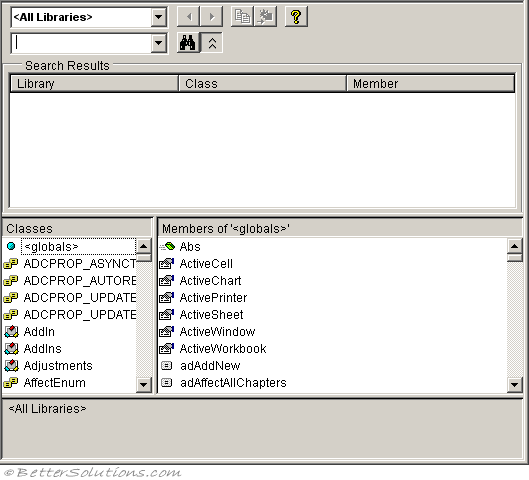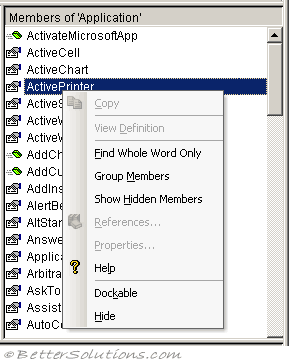Object Browser
The Object Browser displays all the objects that can be found within an application and lists all their properties and methods.
There are also links from the object browser to the online help. The Object Browser can be activated from (View > Object Browser) or by pressing F2.
Alternatively you can click the button on the standard toolbar.
Once you select a library, you can search for a particular text string to get a list of properties and methods that contain text.
The scroll box in the middle contains a list of all the various classes of objects, where a class is just a description of a type of object.
This is a valuable tool for discovering the properties, methods and events applicable to particular objects.
Select Excel library of objects
Choose the Application object on the Right Hand Side.
On the Left Hand Side is a list of all the properties, methods and events that are exposed by that object.
SS
You can group these together
Right click and select Group Members
1) Properties
2) Methods
3) Events
The objects are listed in the window with the title Classes
You can click in this window and type a letter to see all the objects beginning with that letter.
Alternatively you can click in the search box, second from the top with the binoculars to its right and type in the object you are looking for.
When you press Enter or click the binoculars you will see a list containing this text.
When you click on a particular object in the Search Results this object will be displayed below (and selected in the Classes list).
The list of properties, methods and events for this object are sorted alphabetically.
If you right click this list, you can choose Group Members to separate the properties, methods and events.
If you select a particular property, method or event you can press the question mark button to display the appropriate help page.
Any references you add to your project will automatically get added to the libraries drop down list in the Object Browser.
In the listbox in the upper left corner you can limit the display to objects belonging to a specific library.
 |
This is a very useful window because it displays an object model in a nice flat structure
The Object Browser displays all the objects that can be found within an application and lists all their properties and methods. There are also links from the object browser to the online help.
The Object Browser can be activated from (View > Object Browser) or by pressing F2. Once you select a library, you can search for a particular text string to get a list of properties and methods that contain text. The scroll box in the middle contains a list of all the various classes of objects, where a class is just a description of a type of object.
The Object Browser contains three panes
Classes Pane
Displays an alphabetical list of all the available objects and collections. Selecting an object or collection will automatically change the members shown in the Members pane.
Displays an alphabetical list of all the available objects and collections. Selecting an object or collection will automatically change the members shown in the members pane
Members Pane
Displays all the properties and methods for the currently selected object or collection in the Class pane. Selecting a property or method will automatically change the ?? pane.
Displays all the properties and methods for the currently selected object or collection a property or method will automatically change the ?? Pane
TextBox Pane
Displays useful information about the selected property or method.
WHAT DO THE DIFFERENT ICONS MEAN ???????/
Show Hidden Members
The "Show hidden members" option will allow you to see keywords which appear greyed out.
When you look at a PIA it will also show you helper objects.
 |
Group Members
Under normal circumstances the keywords are listed alphabetically.
By selecting Group members you can have the entries ordered in groups
That is first all the properties, then the methods, and then the events
Displays the classes, properties, methods, events, and constants available from object libraries and the procedures in your project. You can use it to find and use objects you create, as well as objects from other applications.
You can get Help for the Object Browser by searching for Object Browser in Help.
Window Elements Project/Library Box
Displays the currently referenced libraries for the active project. You can add libraries in the References dialog box. <All Libraries> allows all of the libraries to be displayed at one time.
Search Text Box
Contains the string that you want to use in your search. You can type or choose the string you want. The Search Text box contains the last 4 search strings that you entered until you close the project. You can use the standard Visual Basic wildcards when typing a string.
If you want to search for a whole word, you can use the Find Whole Word Only command from the shortcut menu.
Go Back Button - Allows you to go back to the previous selection in the Classes and Members of lists. Each time you click it you move back one selection until all of your choices are exhausted.
Go Forward Button - Allows you to repeat your original selections in the Classes and Members of lists each time you click it, until you exhaust the list of selections.
Copy to Clipboard Button - Copies the current selection in the Members of list or the Details pane text to the Clipboard. You can then paste the selection into your code.
View Definition Button - Moves the cursor to the place in the Code window where the selection in the Members of list or the Classes list is defined.
Help Button - Displays the online Help topic for the item selected in the Classes or the Members of list. You can also use F1.
Search Button - Initiates a search of the libraries for the class or property, method, event or constant that matches the string you typed in the Search Text box, and opens the Search Results pane with the appropriate list of information.
Show/Hide Search Results Button - Opens or hides the Search Results pane. The Search Results pane changes to show the search results from the project or library chosen in the Project/Library list. Search results are listed alphabetically from A to Z.
Search Results List
Displays the library, class, and member that corresponds to the items that contain your search string. The Search Results pane changes when you change the selection in the Project/Library box.
Classes List
Displays all of the available classes in the library or project selected in the Project/Libraries box. If there is code written for a class, that class appears in bold. The list always begins with <globals>, a list of globally accessible members.
If you select a Class and do not specify a member, you will get the default member if one is available. The default member is identified by an asterisk (*) or by the default icon specific to the member.
Members of List
Displays the elements of the class selected in the Classes pane by group and then alphabetically within each group. Methods, properties, events, or constants that have code written for them appear bold. You can change the order of this list with the Group Members command on the Object Browser shortcut menu.
Details Pane
Shows the definition of the member. The Details pane contains a jump to the class or library to which the element belongs. Some members have jumps to their parent class. For example, if the text in the Details pane states that Command1 is declared as a command button type, clicking on command button takes you to the Command Button class.
You can copy or drag text from the Details pane to the Code window.
© 2025 Better Solutions Limited. All Rights Reserved. © 2025 Better Solutions Limited TopPrevNext